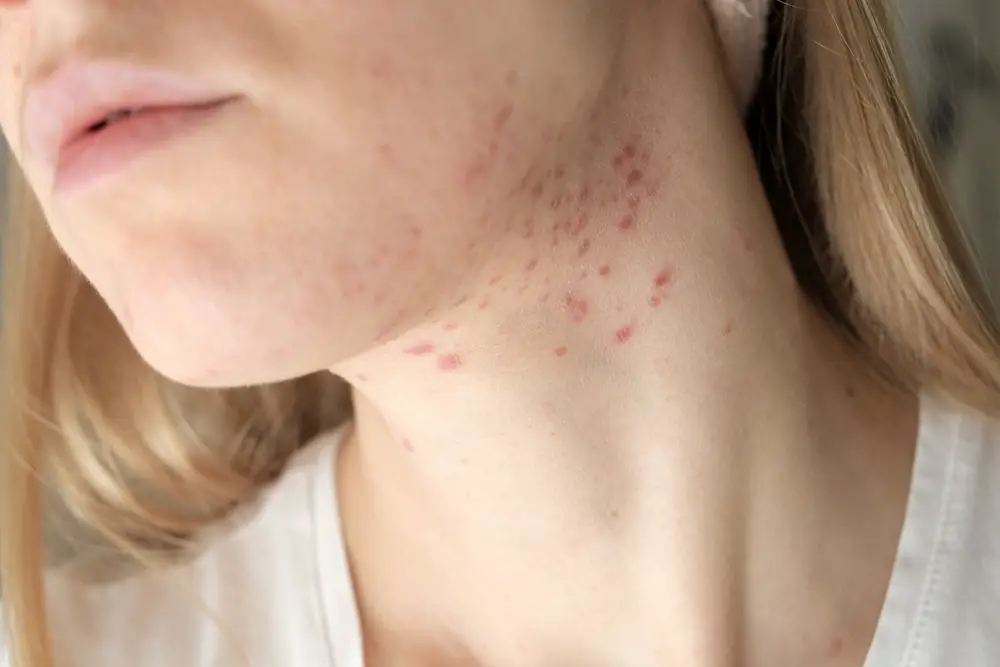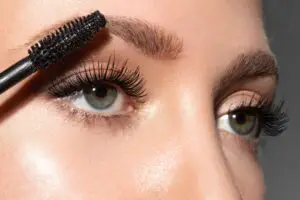Hyaluronic acid is a popular skincare ingredient known for its ability to retain moisture and promote skin hydration. Often found in serums, moisturisers, and anti-ageing products, it has become a go-to ingredient for many looking to improve their overall skin health.
In recent years, there has been some debate as to whether hyaluronic acid can cause acne or if, in fact, it may actually be beneficial in treating the condition.
The general consensus among experts is that hyaluronic acid is not comedogenic, meaning it does not clog pores, which is a primary cause of acne breakouts. It has even been found to have antioxidant properties that help calm redness, inflammation, and irritation associated with acne-prone skin.
However, the overall effect of hyaluronic acid on acne can be influenced by the specific formulation of the skincare product and the presence of other comedogenic ingredients.
In order to get the most out of hyaluronic acid for acne-prone skin, it is important to choose products that are free from potentially comedogenic ingredients and to use the acid in conjunction with other acne-fighting treatments, such as salicylic acid, benzoyl peroxide, and retinoids. By doing so, hyaluronic acid can be an effective part of a skincare regimen for those struggling with acne.
What Is Hyaluronic Acid
Hyaluronic acid is a naturally occurring substance in our body, primarily found in the skin, connective tissues, and eyes. It plays a significant role in maintaining hydration and elasticity in the skin. This incredible molecule can hold up to 1000 times its weight in water, making it a popular ingredient in skincare products to effectively moisturise and maintain the skin’s hydration levels.
In the world of skincare, hyaluronic acid is well known for its powerful hydrating properties. It functions as a humectant, attracting and retaining moisture in the skin. This remarkable ability makes hyaluronic acid a go-to ingredient for various skincare products, including serums, creams, and facial masks, catering to different skin types and concerns.
Besides its moisturising capabilities, hyaluronic acid also helps maintain and improve skin elasticity, reduce the appearance of wrinkles, and promote healthier, rejuvenated skin. Furthermore, it plays a crucial role in joint health, acting as a lubricant and shock absorber, contributing to joint mobility and overall joint health.
Given its wide range of benefits and uses, hyaluronic acid is often regarded as a super-ingredient in the skincare industry. Its highly sought-after properties make it a reliable and effective choice for maintaining skin health and addressing various skin issues, such as dryness, fine lines, and dullness, among others.
Potential Causes of Acne
Hyaluronic acid is a popular skin care ingredient, known for its hydrating properties. However, it is crucial to consider the potential causes of acne before determining if hyaluronic acid can exacerbate the condition.
Acne can manifest in various forms, such as non-inflammatory clogged pores, also known as comedones (whiteheads and blackheads), and inflammatory pimples or papules and pustules, with cysts and nodules being more severe cases of inflammatory acne.
Factors that typically contribute to acne include hormonal changes experienced during puberty or pregnancy, age, as teenagers are more prone to developing acne, and family history.
Knowing these factors can provide insight into whether hyaluronic acid plays a role in causing acne.
There is evidence that suggests low molecular weight hyaluronic acid (LMWHA) can induce inflammation in the skin and potentially cause acne breakouts. However, high molecular weight hyaluronic acid (HMWHA) is thought to be less likely to cause acne, but may result in skin dehydration in a dry climate.
It is important to note that research on hyaluronic acid’s effects on acne is limited and should be interpreted cautiously. As with any skincare product, individual experiences may vary. It is beneficial to consult a dermatologist or a skin care specialist to determine the most suitable products for one’s specific skin type and concerns.
Hyaluronic Acid and Acne
Hyaluronic acid is a naturally occurring substance in the body, often found in the skin, connective tissues, and eyes. In skincare products, hyaluronic acid is known for its powerful hydrating properties, as it can hold 1000 times its weight in water when fully absorbed into the skin.
Given its moisturising capabilities, you may wonder if hyaluronic acid can be beneficial for acne-prone skin or if it might trigger breakouts. In general, hyaluronic acid is considered safe for those with acne-prone skin because it helps maintain the skin’s natural moisture balance, which is an essential aspect of skincare.
There is some evidence that using hyaluronic acid may provide benefits for acne as well. For example, its moisturising properties can prevent excessive dryness, which may contribute to acne development. By keeping the skin hydrated, hyaluronic acid may also help reduce the appearance of acne scars and promote a smoother complexion.
Furthermore, the chances of hyaluronic acid causing acne are relatively low. Unlike some other skincare ingredients, hyaluronic acid is not known to clog pores or cause breakouts. In fact, research suggests it is safe to use in skincare products, with minimal risks of side effects, even for those who are pregnant or nursing.
That being said, it is crucial to follow a suitable skincare routine and use products that are compatible with your skin type. When using hyaluronic acid, experts recommend combining it with other non-comedogenic and gentle skincare products to minimise the risk of irritation or breakouts.
In summary, hyaluronic acid is a beneficial and safe ingredient for those with acne-prone skin. By maintaining the skin’s moisture balance, it can potentially prevent acne development and improve overall skin health.
Factors That May Increase Acne Risk with Hyaluronic Acid
Product Formulation
The formulation of a hyaluronic acid product can influence its potential to cause acne. Some products may contain specific ingredients like comedogenic oils or fragrances that can trigger breakouts in acne-prone individuals. It is always recommended to check the ingredient list before trying any new skincare product, especially if you have sensitive or acne-prone skin.
Opt for non-comedogenic and fragrance-free options whenever possible.
Skin Type
Your skin type plays a crucial role in determining how hyaluronic acid affects your skin. Individuals with oily or combination skin may experience increased acne risk, as their skin is more prone to clogged pores and bacterial growth.
On the other hand, those with dry or sensitive skin may not experience any adverse effects. It’s essential to understand your skin type and choose products specifically formulated for it.
Application Technique
The way you apply hyaluronic acid to your skin can also impact its potential to cause acne. Overusing or applying the product to unclean skin can lead to clogged pores and breakouts. Ensure that you cleanse your face thoroughly before applying any skincare products, including hyaluronic acid.
Moreover, follow the recommended amount and frequency of the product to minimise the risk of irritation or breakouts. Always patch test a new product on a small area of skin to assess its compatibility with your skin type before incorporating it into your daily routine.
Benefits of Hyaluronic Acid for Skin
Hyaluronic acid is a naturally occurring substance that plays an important role in skin health. It provides various skin benefits, including moisturisation, anti-aging effects, and wound healing. In this section, we will discuss these benefits in detail.
Moisturisation
Hyaluronic acid is well known for its hydrating properties. It has the ability to draw moisture from the surrounding environment and bind it to the skin, thereby increasing skin hydration and reducing dryness.
This effect can help improve the appearance of dry or flaky skin, as well as provide relief for those with sensitive or irritated skin. Hyaluronic acid’s intense hydration also helps to control sebum production in oily skin and decrease inflammation.
Anti-Aging Effects
One of the most notable benefits of hyaluronic acid is its ability to plump and smooth the skin, which can improve the appearance of fine lines and wrinkles. By increasing the skin’s moisture content, hyaluronic acid helps to support the skin’s natural elasticity and reduce the visible signs of aging.
Furthermore, it contains antioxidant properties that can protect the skin from environmental damage and help to maintain a youthful appearance.
Wound Healing
Hyaluronic acid has also been shown to improve wound healing by promoting cell regeneration and reducing inflammation. When applied to cuts, burns, or other skin injuries, it provides a protective layer and helps to maintain moisture, which is essential for optimal healing.
Additionally, hyaluronic acid can expedite the recovery process, reducing the time it takes for wounds to heal and minimising the risk of scarring.
In summary, hyaluronic acid offers numerous benefits for skin health. It is an essential component of a well-rounded skincare routine that can help to boost hydration, minimise the signs of aging, and promote faster wound healing.
How to Use Hyaluronic Acid Safely
Hyaluronic acid is a popular skin care ingredient known for its hydrating and plumping effects. To ensure you receive the benefits without the risk of adverse effects, it’s essential to understand how to use hyaluronic acid safely. In this section, we’ll go through two key steps: Patch Testing and Proper Usage.
Patch Testing
Before incorporating hyaluronic acid into your regular skincare routine, it’s important to perform a patch test. A patch test can help identify any allergies or sensitivities you might have to the product.
- Apply a small amount of the hyaluronic acid product to the inside of your forearm.
- Cover the area with a bandage or plaster.
- Leave the product on your skin for 24 hours.
- Remove the bandage and check for any signs of irritation, redness, or swelling.
If you notice any adverse reactions, discontinue using the product. If there’s no irritation, you can safely proceed to incorporate hyaluronic acid into your skincare regimen.
Proper Usage
To reap the benefits of hyaluronic acid without the risk of irritation or breakouts, follow these guidelines for proper usage:
- Cleanse: Begin by cleansing your face with a gentle cleanser to remove any dirt or makeup.
- Damp skin: Apply hyaluronic acid to damp skin, as it works best when your skin is slightly moist. This will help the product better absorb and provide optimal hydration.
- Layering: If you’re using a hyaluronic acid serum, apply it before your moisturiser. This will allow the moisturiser to lock in the hydration provided by the serum.
- Don’t overdo it: Using too much hyaluronic acid can potentially lead to breakouts or exacerbate existing acne. Stick to the recommended amount on the product’s label.
By patch testing and following proper usage guidelines, you can confidently and safely incorporate hyaluronic acid into your skincare routine.
Alternatives to Hyaluronic Acid
While hyaluronic acid is widely used as a moisturising ingredient in skincare products, it may not be suitable for everyone, particularly those worried about acne. Fortunately, there are alternatives available. These alternatives can provide similar benefits, and may be a better option for some individuals.
Glycerin
Glycerin, also known as glycerol, is a humectant that attracts and retains moisture in the skin, similar to hyaluronic acid. Glycerin is a natural component of healthy skin and can mimic the skin’s natural moisturising factors. It is suitable for various skin types, including oily and acne-prone skin.
One of the key benefits of glycerin is that it is non-comedogenic, meaning it won’t clog pores or cause breakouts. In fact, it can help improve skin barrier function and reduce irritation associated with acne.
Glycerin-based products are widely available and can be found in a range of formulations, including cleansers, toners, and moisturisers. Make sure to choose a product that is specifically designed for your skin type to maximise its benefits.
Ceramides
Ceramides are lipids found naturally in the skin that help maintain the skin’s barrier function and retain moisture. They can be an excellent alternative to hyaluronic acid for those with acne-prone skin.
Ceramides are particularly beneficial for individuals with dry or sensitive skin, as they help to replenish and retain moisture while also improving the skin’s barrier function. This can prevent the overproduction of oil and reduce the risk of breakouts. Ceramide-containing products are available in various forms, including creams, serums, and lotions.
When looking for skincare products containing ceramides, opt for formulations that are free from irritants, such as fragrances and harsh chemicals. Additionally, choose products that are non-comedogenic to avoid clogging pores and causing acne flare-ups.
By considering glycerin and ceramides as alternatives to hyaluronic acid, individuals with acne-prone skin can still achieve the moisturising benefits without the risk of exacerbating their acne.

I’m Jennifer a beauty and wellness expert. I believe in promoting a sustainable and healthy lifestyle from within. Helping people feel good is my passion; whether it’s teaching yoga or offering skincare advice.







